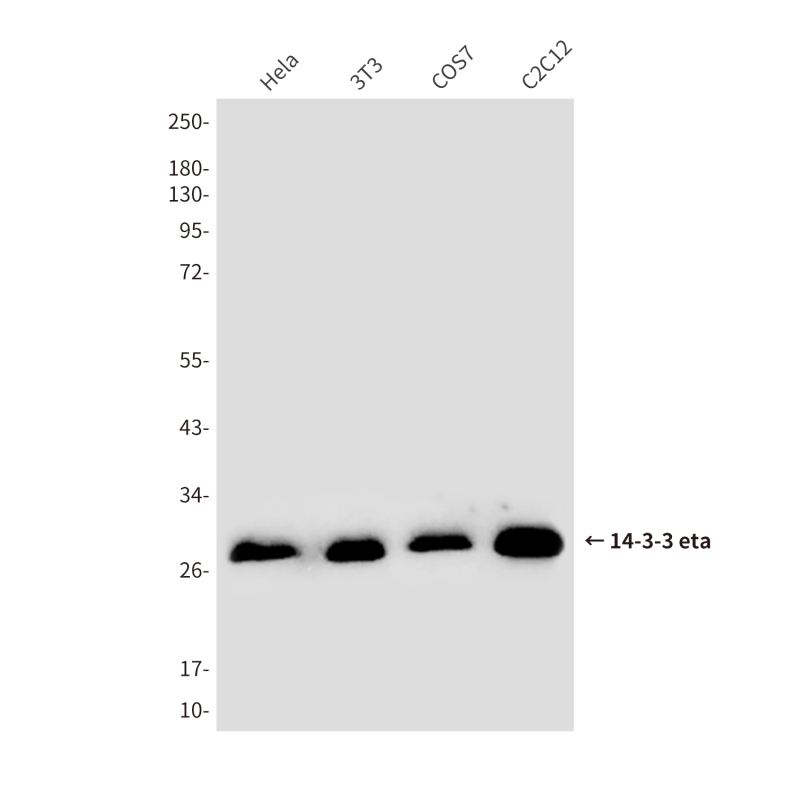
| WB | 咨询技术 | Human,Mouse,Rat |
| IF | 咨询技术 | Human,Mouse,Rat |
| IHC | 咨询技术 | Human,Mouse,Rat |
| ICC | 技术咨询 | Human,Mouse,Rat |
| FCM | 咨询技术 | Human,Mouse,Rat |
| Elisa | 咨询技术 | Human,Mouse,Rat |
| Aliases | 14-3-3 protein eta; 1433F_HUMAN; Brain protein 14-3-3; eta isoform; HGNC:12853; Protein AS1; Tyrosine 3/tryptophan 5 monooxygenase activation protein eta polypeptide; YWHA 1; YWHA1; Ywhah. |
| Entrez GeneID | 7533 |
| clone | 5H2 |
| WB Predicted band size | Calculated MW: 28 kDa; Observed MW: 28 kDa |
| Host/Isotype | Mouse IgG |
| Antibody Type | Primary antibody |
| Storage | Store at 4°C short term. Aliquot and store at -20°C long term. Avoid freeze/thaw cycles. |
| Species Reactivity | Human,Mouse,Rat |
| Immunogen | Antibodies are produced by immunizing animals with a synthetic peptide corresponding to the sequence of human 14-3-3 η. |
| Formulation | Purified antibody in PBS with 0.05% sodium azide,0.5%BSA and 50% glycerol. |
+ +
以下是关于14-3-3η抗体的3篇代表性文献及其摘要概述:
1. **文献名称**:*14-3-3η is a novel mediator associated with the pathogenesis of rheumatoid arthritis and joint damage*
**作者**:Maksymowych WP, et al.
**摘要**:该研究首次提出14-3-3η蛋白在类风湿关节炎(RA)患者血清中显著升高,其作为生物标志物的敏感性和特异性优于传统标志物(如RF和抗CCP),并与关节炎症和影像学损伤进展相关。
2. **文献名称**:*Utility of serum 14-3-3η protein for diagnosis of early rheumatoid arthritis*
**作者**:Hirata S, et al.
**摘要**:研究证明,14-3-3η抗体在早期RA患者中具有较高的诊断价值,尤其在抗CCP抗体阴性的患者中可作为补充指标,且其水平与疾病活动度(DAS28评分)呈正相关。
3. **文献名称**:*14-3-3η: A potential biomarker for stratification of autoimmune diseases*
**作者**:Abu-Shakra M, et al.
**摘要**:综述分析了14-3-3η在多种自身免疫病(如SLE、银屑病关节炎)中的表达差异,强调其在RA中的特异性,并探讨其通过调控炎症信号通路(如NF-κB)参与疾病机制的分子机制。
4. **文献名称**:*Comparative analysis of 14-3-3η autoantibodies in seropositive and seronegative rheumatoid arthritis*
**作者**:Elkayam O, et al.
**摘要**:研究发现,14-3-3η抗体在血清阴性RA患者中仍有一定检出率,提示其可作为传统抗体阴性患者的辅助诊断工具,并可能预测对TNF-α抑制剂的治疗反应。
---
以上文献均聚焦于14-3-3η抗体在RA诊断、预后评估及机制研究中的应用,如需具体发表年份或期刊,可进一步补充检索。
The 14-3-3η (eta) antibody is a relatively novel biomarker associated with rheumatoid arthritis (RA), an autoimmune disorder characterized by joint inflammation and damage. The 14-3-3 protein family consists of intracellular chaperone proteins involved in regulating cell signaling, apoptosis, and stress responses. The eta isoform (14-3-3η) is expressed extracellularly in RA synovial fluid and has been identified as an autoantigen, triggering antibody production in some patients.
Discovered in the early 2010s, 14-3-3η antibodies gained attention for their diagnostic and prognostic utility in RA. Unlike traditional RA biomarkers like rheumatoid factor (RF) and anti-cyclic citrullinated peptide (anti-CCP), 14-3-3η antibodies may appear earlier in the disease course, aiding in early diagnosis. Studies suggest that 14-3-3η has moderate sensitivity (~60-70%) but high specificity (>90%) for RA, particularly in seronegative patients (negative for RF/anti-CCP). Its presence correlates with severe disease phenotypes, including higher inflammatory activity, radiographic joint damage, and poor treatment response.
Clinically, 14-3-3η testing is often used alongside RF and anti-CCP to improve diagnostic accuracy. It also shows potential in predicting disease progression and guiding personalized therapies. While its exact pathogenic role remains unclear, 14-3-3η is hypothesized to promote pro-inflammatory cytokine production and osteoclast activation, contributing to joint destruction. Ongoing research explores its broader applications in autoimmune and inflammatory conditions.
×